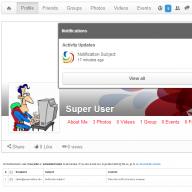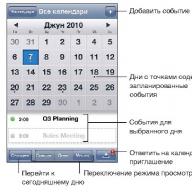Have you ever encountered a situation where a picture looks correct on your computer, but when uploaded to an Internet site, it turns out to be upside down? I upload photos to websites a lot and often and I encounter this often. Sometimes the problem is easily solved, for example, in the WordPress console, when managing media files, any photo can be rotated. But not all websites allow this; for example, this problem is relevant for users of mail.ru, as well as for a number of other sites, including sites based on custom-written engines.
The easiest way to avoid this is to first rotate your photos on your computer. But that’s the problem - on the computer the photos look correct, but these same photos “stand sideways” when uploaded to the Internet:
The fact is that the programs on the computer are “smart”, they can read EXIF meta-information, and this information says that the photo must be rotated. Accordingly, on the computer you always see pictures from the correct angle. But among Internet services, not all are so “smart” - some do not know how to work with EXIF data, so it turns out that pictures look incorrect on the Internet.
This cannot be done using standard Windows programs; you have to look for other solutions. I found two such solutions for myself, both of them require the installation of additional programs, but these programs are completely free.
1) Rotate images using GIMP
Hidden from guests
Open a photo that, when uploaded to the Internet, lies on its side with GIMP:
Immediately when opening a file, the program asks if it needs to be rotated. We agree with the program and immediately save our file. In GIMP, instead of “Save” you need to select “Export as”.
I processed several photos in this way, but this method quickly disappointed me: if there are a lot of photos, then we cannot know which of them is upside down, since the standard explorer shows them correctly. So you can get confused. In addition, open it, click the “Rotate” button, select the export option, and change the settings there - honestly, this is very long and not suitable for modern hectic life. So I started looking for another option.
2. FastStone Image Viewer – advanced photo viewer
My father recommended the program to me
Hidden from guests
Hidden from guests
). This program is free for personal use. This program has a huge number of advantages specifically for viewing photos - it understands different gestures, offers additional functions when pointing at different sides of the screen, easily enlarges photos for detailed study, etc. - a very useful and very functional program - but now we are interested in something slightly different , I recommend that you study it yourself.
I tried the program and upon a quick glance it did not live up to my expectations - all the pictures were smoothed out correctly, although there were some problematic ones among them.
I went to the settings and pretty quickly found what I needed there:
You need to uncheck the box “ Auto-rotate according to orientation tag in EXIF" And more is needed clear the thumbnail database:
What do you do in this situation, what programs do you use?
The main thing is to specify the picture on your computer or phone, if necessary, specify the type of mirror image, and click OK at the bottom. The rest of the settings are already set to default.
Examples with mirrored photographs: 



The first example above is the original photo of a yellow cucumber flower, that is, without modifications. To create the second example, a horizontal mirror image was used (from left to right), and for the third example, a vertical mirror image was used. The photo of the Kodak battery was reflected using the standard method - horizontally.
This online tool can work without recompression and without loss of quality when saving in jpg format. To do this, you need to check the appropriate box in the “output image format” settings.
The use of mirror reflection will not only allow you to correctly correct the position of a photograph or picture, but will also allow you to look at it in a new way. Try it and see for yourself! This site also has similar effects: mirror collage, mirror reflection under the picture and the looking glass effect.
The original image is not changed in any way. You will be provided with another processed image.
If you love traveling and photography, then by the end of each trip you probably have a lot of wonderful photos. Unfortunately, some photos are rotated 90 degrees to the left or right, which can be awkward to view on a computer or mobile device. The situation is even more unpleasant when the horizon is “cluttered” in the picture. This makes the photos look unprofessional and does not produce the desired effect. But this does not mean that you need to delete such photos, buy a tripod and carry it with you everywhere! The right photo processing program will help you solve these problems.
We suggest you use Movavi Photo Editor. With its help, you can not only flip the photo and align the horizon line, but also change color settings, overlay text, remove unnecessary objects from the photo and much more. A simple and intuitive interface will allow you to easily cope with all these tasks, even if you have no experience in photo editing. To make sure of this, download our Photo Editor and follow the instructions below, which are suitable for both the Windows and Mac versions of the program.
1. Install a photo editor
Open the downloaded file and follow the instructions on your computer screen. After installation is complete, launch Movavi Photo Editor by double-clicking on the program icon.
2. Upload the file to the program
Click Open file and select the image you want to edit, or simply drag and drop the file into the Photo Editor window.
3. Rotate the image
At the top of the program window there is a toolbar for editing photos. Select Turn. Under the heading Turn There are two buttons: press left or right to rotate the photo 90 degrees in the corresponding direction. Buttons under the title Reflection serve to mirror the image vertically and horizontally.

There are two ways to align the horizon line in Movavi Photo Editor. The first way is to adjust the image angle manually. To do this, drag the slider on the scale Alignment angle in the direction where you want to rotate the image. To the right of the scale it shows how many degrees the image has been rotated. Here you can independently set the exact value of the angle of inclination, if necessary.

The second way is to use the tool Level for automatic leveling. To do this, click the button Set level and using the left mouse button, draw a line on the image along the line, which should be strictly horizontal/vertical in the final image. For example, the chain on which a heavy lamp is suspended is always vertical, but the boundary between the sky and water when shooting a seascape should be strictly horizontal. Immediately after drawing the line, the photo will be automatically rotated and cropped in accordance with the set level.
In this program, it is also quite common to select different parts of the drawing in order to cut them out, replace them, or rotate them. The article, selecting objects in Photoshop, describes various ways how this can be done.
Now let's figure out what you can do if you need to flip an image in Photoshop to a mirror image or by a few degrees. This is useful if a picture or photograph stored on a computer is rotated 90 degrees clockwise or counterclockwise because the person was holding the camera or phone at the wrong angle during shooting. Or you need to make a collage of several photos or pictures. Then frames rotated at different angles will look more interesting on it.
How to rotate a photo through the menu
Open the image you will be working with in Photoshop. Next, click on the “Image” menu item at the top and select “Image Rotation” from the list. The additional menu will have several different items.
Here you can choose to rotate 180 degrees or 90 clockwise (“CW”) or counterclockwise (“CCW”). “Flip Canvas Horizontal” – used if you need to flip it in a mirror manner. Accordingly, “Flip Canvas Vertical” is a reflection of the picture vertically.
By selecting “Arbitrary”, a window like this will appear. In it, specify the exact angle to rotate the picture or photo in the “Angle” field. Next, use a marker to mark which direction to rotate: “CW” – clockwise, “CCW” – counterclockwise. Click OK.

The picture will be flipped by the specified angle: clearly 90 or 180 degrees or by an arbitrary value.

Using Free Transform
You can also rotate the image in the following way. But before activating this mode, you need to make sure that the layer with the pattern that we will rotate is not blocked - there should not be a lock opposite it.
In the example the layer is locked. To remove the lock, double-click on the layer. A window like this will appear. You don’t need to change anything in it, just click “OK”.

Now press “Ctrl+T” on your keyboard. A frame with markers will appear around the object. Move the mouse cursor outside the picture to any marker. When the cursor changes to an arrow, press the left mouse button and rotate the image. After turning, release the button.
In Free Transform mode, you can rotate the image as you wish, or specify the exact rotation value in the corresponding field in the top menu.
If, while rotating a picture with the mouse, hold down “Shift” on the keyboard, then the rotation will occur at a clearly defined step: each time plus 15 degrees. That is: 15, 30, 45, 60, 75, 90 degrees and so on.

By activating Free Transform, you can rotate the active layer separately or a pre-selected area on this layer. To exit the mode, press the “ESC” button.
Rotate the layer using the Rotate View tool
Another method you can use is the Rotate View Tool button. You can select the corresponding menu item on the toolbar, or you can use hotkeys and press “R”.

After that, move the cursor over the drawing. Click on it with the left mouse button and, without releasing it, rotate it. An arrow similar to a compass arrow will appear. When you rotate the image to the desired angle, release the mouse button.

Choose the method that suits you to rotate the desired image layer. Rotation through the “Image” menu is suitable if you have one layer: a picture or a photograph. If you are making a collage, then it is better to use free transformation so that you can rotate a certain layer or selected object in the picture in Photoshop. And use Rotate View to see how a layer will look from a certain angle.
Rate this article:This situation occurs quite often. Imagine you took some photos with your phone. Transfer them to your computer and... They turn out to be upside down. How can I turn them back to their original position?
Here's an example of what a photo might look like:

Agree, viewing such images with your head turned 90 degrees is at least inconvenient.
To rotate a photo, you need to use the application installed on the Windows operating system. For example, if you open an image using the Windows Photo Viewer, you will see something like this:

To flip the image, click on the arrow. Which one depends on which direction your image is rotated. In my case, you need to click on the left arrow (highlighted in red). After this, the photo will take the correct position.

After this procedure, you can close the window - the photo will not change its position.
Of course, you can always use another application. For example, there is a Paint application built into Windows OS. Right-click on the photo and select "Open with Paint."

The photo will open in the Paint editor. From the top menu, select "Edit" and then rotate the image the way you want.

The image has taken the correct position. Be sure to save it by pressing CTRL+S.

To flip the photo as a mirror, in the same Paint, select “Flip Horizontal”.

Then save the image.
As you can see, nothing complicated. With any graphics application at hand, you can easily flip a photo. And for this you don’t need to install powerful graphic editors like Photoshop; much simpler applications will suffice.




